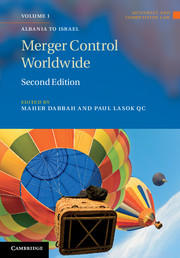Book contents
- Frontmatter
- Contents
- Preface
- List of Contributors
- Table of cases
- Table of Legislation and Official Guidance
- Introduction
- Albania
- Argentina
- Armenia (Republic of Armenia)
- Australia
- Austria
- Barbados
- Belgium
- Bosnia and Herzegovina
- Brazil
- Bulgaria (Republic of Bulgaria)
- Canada
- Chile
- China*
- Costa Rica
- Croatia
- Cyprus (Republic of Cyprus)
- Czech Republic
- Denmark
- Estonia
- European Economic Area
- European Union
- Finland
- France
- Germany (Federal Republic of Germany)
- Greece
- Hong Kong
- Hungary
- Iceland
- India
- Indonesia (Republic of Indonesia)
- Ireland
- Israel
- Italy
- Japan
- Kenya
- Korea
- Latvia
- Lithuania
- Macedonia (Republic of Macedonia)
- Malta
- Mexico
- Netherlands (The Netherlands)
- New Zealand
- Norway
- Pakistan
- Peru
- Philippines (Republic of the Philippines)
- Poland
- Portugal
- Romania
- Russia
- Serbia
- Singapore
- Slovakia (Slovak Republic)
- Slovenia
- South Africa
- Spain
- Sri Lanka
- Sweden
- Switzerland
- Taiwan
- Thailand
- Tunisia (Republic of Tunisia)
- Turkey
- Ukraine
- United Kingdom
- United States of America
- Uzbekistan
- Venezuela
- Zambia
- Index
Argentina
Published online by Cambridge University Press: 05 November 2014
- Frontmatter
- Contents
- Preface
- List of Contributors
- Table of cases
- Table of Legislation and Official Guidance
- Introduction
- Albania
- Argentina
- Armenia (Republic of Armenia)
- Australia
- Austria
- Barbados
- Belgium
- Bosnia and Herzegovina
- Brazil
- Bulgaria (Republic of Bulgaria)
- Canada
- Chile
- China*
- Costa Rica
- Croatia
- Cyprus (Republic of Cyprus)
- Czech Republic
- Denmark
- Estonia
- European Economic Area
- European Union
- Finland
- France
- Germany (Federal Republic of Germany)
- Greece
- Hong Kong
- Hungary
- Iceland
- India
- Indonesia (Republic of Indonesia)
- Ireland
- Israel
- Italy
- Japan
- Kenya
- Korea
- Latvia
- Lithuania
- Macedonia (Republic of Macedonia)
- Malta
- Mexico
- Netherlands (The Netherlands)
- New Zealand
- Norway
- Pakistan
- Peru
- Philippines (Republic of the Philippines)
- Poland
- Portugal
- Romania
- Russia
- Serbia
- Singapore
- Slovakia (Slovak Republic)
- Slovenia
- South Africa
- Spain
- Sri Lanka
- Sweden
- Switzerland
- Taiwan
- Thailand
- Tunisia (Republic of Tunisia)
- Turkey
- Ukraine
- United Kingdom
- United States of America
- Uzbekistan
- Venezuela
- Zambia
- Index
Summary
Although Argentina’s first competition law dates back to 1923, a merger-control regime was introduced only in 1999. The 1990s in Argentina’s case are widely considered a period in which unprecedented measures to foster foreign investment were introduced. Perhaps the most relevant of those measures was the Government’s decision to privatise most state-owned companies. As the twentieth century drew to a close the privatisation process was however subject to harsh criticism, in part due to the competition problems caused. A notable example of a transaction giving rise to such criticism – and which went largely unchecked – was the sale of the oil and gas conglomerate, YPF to the Spanish energy company, Repsol. The legislative reaction to the criticism and the YPF/Repsol transaction was the passing of the Competition Act 25,156, which entered into force in September 1999 and which included a specific mechanism dealing with mergers (‘the Act’).
However, prior to the adoption of the Act controlling mergers was not absolutely beyond the reach of Argentina’s system of competition law. In fact, the Act’s predecessor, Competition Act 22,262 of 1980, did in theory allow for the possibility of certain mergers being reviewed, but only through an ex-post investigation, as was the case with regard to other business phenomena giving rise to competition concerns, notably anti-competitive agreements and abuses of dominance. Nonetheless, this was not a suitable way to deal with a business phenomenon such as mergers.
- Type
- Chapter
- Information
- Merger Control Worldwide , pp. 43 - 60Publisher: Cambridge University PressPrint publication year: 2012



